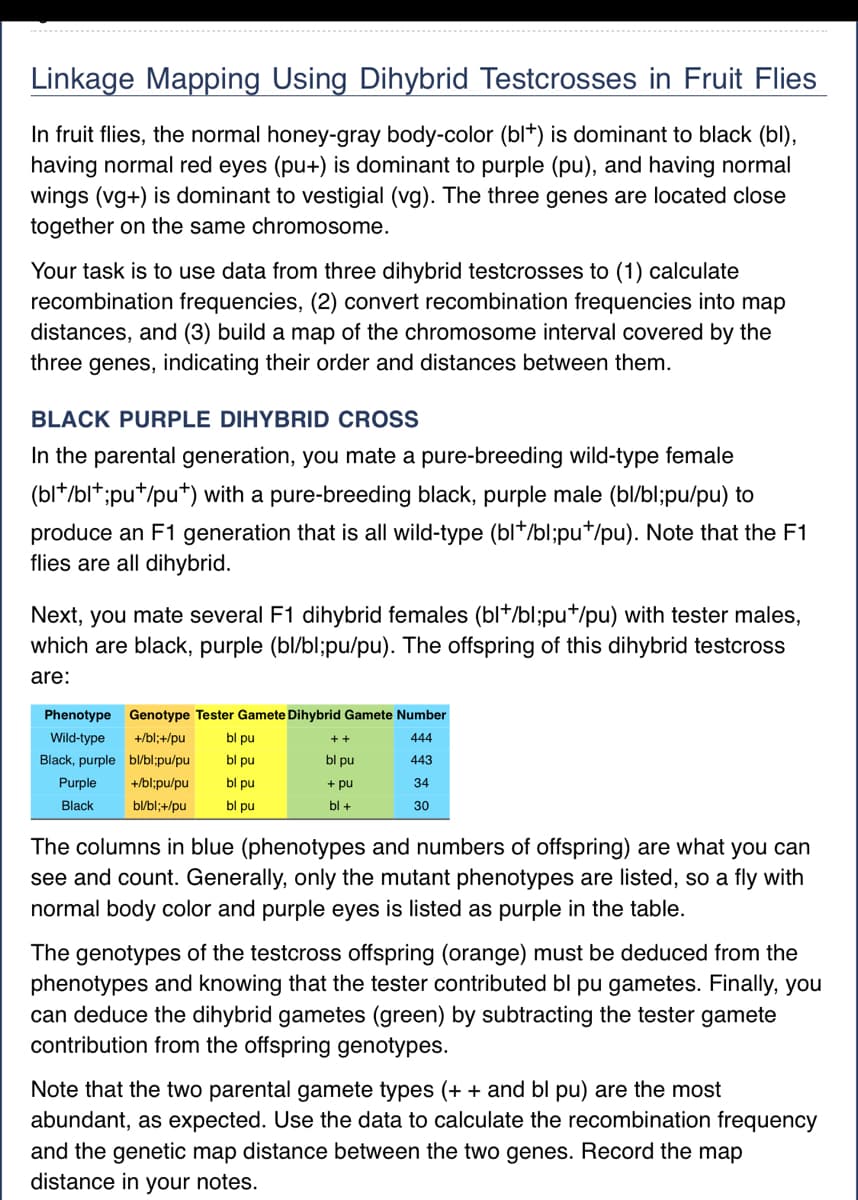Note that the two parental gamete types (+ + and bl pu) are the most abundant, as expected. Use the data to calculate the recombination frequency and the genetic map distance between the two genes. Record the map distance in your notes.
Note that the two parental gamete types (+ + and bl pu) are the most abundant, as expected. Use the data to calculate the recombination frequency and the genetic map distance between the two genes. Record the map distance in your notes.
Human Heredity: Principles and Issues (MindTap Course List)
11th Edition
ISBN:9781305251052
Author:Michael Cummings
Publisher:Michael Cummings
Chapter6: Cytogenetics: Karyotypes And Chromosome Aberrations
Section: Chapter Questions
Problem 1QP: Analyzing Karyotypes 1. Originally, karyotypic analysis relied only on size and centromere placement...
Related questions
Topic Video
Question

Transcribed Image Text:Linkage Mapping Using Dihybrid Testcrosses in Fruit Flies
In fruit flies, the normal honey-gray body-color (bl*) is dominant to black (bl),
having normal red eyes (pu+) is dominant to purple (pu), and having normal
wings (vg+) is dominant to vestigial (vg). The three genes are located close
together on the same chromosome.
Your task is to use data from three dihybrid testcrosses to (1) calculate
recombination frequencies, (2) convert recombination frequencies into map
distances, and (3) build a map of the chromosome interval covered by the
three genes, indicating their order and distances between them.
BLACK PURPLE DIHYBRID CROSS
In the parental generation, you mate a pure-breeding wild-type female
(bl+/blt;put/pu+) with a pure-breeding black, purple male (bl/bl;pu/pu) to
produce an F1 generation that is all wild-type (bl+/bl;pu*/pu). Note that the F1
flies are all dihybrid.
Next, you mate several F1 dihybrid females (bl+/bl;pu*/pu) with tester males,
which are black, purple (bl/bl;pu/pu). The offspring of this dihybrid testcross
are:
Phenotype Genotype Tester Gamete Dihybrid Gamete Number
+/bl;+/pu
444
bl/blipu/pu
443
Wild-type
Black, purple
Purple
Black
34
+/bl;pu/pu
bl/bl;+/pu
30
bl pu
bl pu
bl pu
bl pul
++
bl pu
+ pu
bl +
The columns in blue (phenotypes and numbers of offspring) are what you can
see and count. Generally, only the mutant phenotypes are listed, so a fly with
normal body color and purple eyes is listed as purple in the table.
The genotypes of the testcross offspring (orange) must be deduced from the
phenotypes and knowing that the tester contributed bl pu gametes. Finally, you
can deduce the dihybrid gametes (green) by subtracting the tester gamete
contribution from the offspring genotypes.
Note that the two parental gamete types (+ + and bl pu) are the most
abundant, as expected. Use the data to calculate the recombination frequency
and the genetic map distance between the two genes. Record the map
distance in your notes.
Expert Solution
This question has been solved!
Explore an expertly crafted, step-by-step solution for a thorough understanding of key concepts.
Step by step
Solved in 2 steps

Knowledge Booster
Learn more about
Need a deep-dive on the concept behind this application? Look no further. Learn more about this topic, biology and related others by exploring similar questions and additional content below.Recommended textbooks for you

Human Heredity: Principles and Issues (MindTap Co…
Biology
ISBN:
9781305251052
Author:
Michael Cummings
Publisher:
Cengage Learning

Human Heredity: Principles and Issues (MindTap Co…
Biology
ISBN:
9781305251052
Author:
Michael Cummings
Publisher:
Cengage Learning